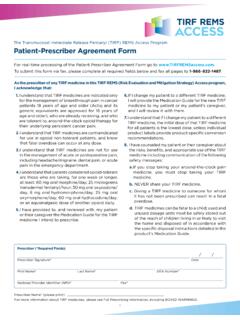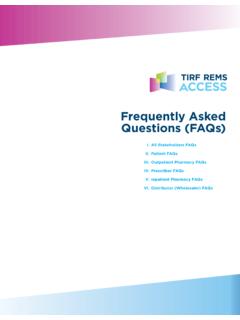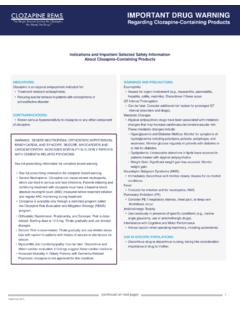Transcription of Transmucosal Immediate Release Fentanyl ... - TIRF …
1 Transmucosal Immediate Release Fentanyl (TIRF) Products Risk Evaluation and Mitigation Strategy ( rems ) education Program for Prescribers and Pharmacists2 Products Covered Under This Program Abstral ( Fentanyl ) sublingual tablets Actiq ( Fentanyl citrate) oral Transmucosal lozenge Fentora ( Fentanyl buccal tablet) Lazanda ( Fentanyl ) nasal spray Onsolis ( Fentanyl buccal soluble film) Subsys ( Fentanyl sublingual spray) Approved generic equivalents of these products are also covered under this programBefore you can enroll in the TIRF rems Access program, you must review the education Program, successfully complete the Knowledge Assessment, and sign the acknowledgement statements on the enrollment form.
2 The education Program and enrollment can be completed online at The enrollment form may also be downloaded from the website on the Resources tab, and completed and faxed into the program at of enrollment is required every 2 years. You will receive a reminder to renew your enrollment at the appropriate writing prescriptions for inpatient use only do not need to enroll in the TIRF rems Access rems Access Program GoalsThe goals of the TIRF rems Access program are to mitigate the risk of misuse, abuse, addiction, overdose, and serious complications due to medication errors by:1. Prescribing and dispensing TIRF medicines only to appropriate patients, which includes use only in opioid-tolerant Preventing inappropriate conversion between Fentanyl Preventing accidental exposure to children and others for whom it was not Educating prescribers, pharmacists, and patients on the potential for misuse, abuse, addiction, and rems Access education Program Overview This education Program contains key safety information critical for minimizing the risks associated with TIRF medicines.
3 The program will address: Appropriate patient selection Understanding each patient s risk factors for misuse, abuse, addiction, and overdose Dosage and administration Patient counseling Effective patient management and follow-upTIRF rems Access education Program3 Information on the TIRF rems Access program requirements and operations is provided in the TIRF rems Access program overviews for prescribers and pharmacies, which can be accessed at education program is NOT a substitute for reading the Full Prescribing Information for each TIRF also review the Full Prescribing Information and familiarize yourself with the contents of the Medication Guide for each product Patient Selection IndicationTIRF medicines are indicated only for the management of breakthrough pain in adult patients with cancer 18 years of age and older who are already receiving and who are tolerant to regular opioid therapy for underlying persistent cancer pain.
4 The only exception is for Actiq and its generic equivalents, which are approved for cancer patients 16 years and medicines are contraindicated in opioid non-tolerant patients because life-threatening respiratory depression and death could occur at any dose in patients not taking chronic of Opioid TolerancePatients considered opioid-tolerant are those who are taking, for one week or longer, at least: 60 mg oral morphine/day 25 mcg transdermal Fentanyl /hour 30 mg oral oxycodone/day 8 mg oral hydromorphone/day 25 mg oral oxymorphone/day OR an equianalgesic dose of another oral opioidTIRF medicines are intended to be used only in the care of opioid-tolerant patients with cancer and only by healthcare professionals who are knowledgeable of, and skilled in, the use of Schedule II opioids to treat cancer medicines must not be used in opioid non-tolerant medicines are contraindicated in the management of acute or postoperative pain, including headache/migraine and dental pain.
5 Please see each TIRF medicine s Full Prescribing Information for a full list of specific situations in which TIRF medicines are not indicated or are medicines are contraindicated in patients with known intolerance or hypersensitivity to any of its components or the drug respiratory depression could occur at any dose in opioid non-tolerant patients. Deaths have occurred in opioid non-tolerant patients treated with some Fentanyl Risk of Misuse, Abuse, Addiction, and OverdoseTIRF medicines contain Fentanyl , an opioid agonist and Schedule II controlled substance. TIRF medicines can be abused in a manner similar to other opioid agonists, legal and risks should be considered when prescribing or dispensing TIRF medicines in situations where the prescriber or pharmacist is concerned about an increased risk of misuse, abuse, addiction, or factors for opioid abuse include.
6 A history of past or current alcohol or drug abuse A history of psychiatric illness A family history of illicit drug use or alcohol abuseConcerns about abuse and addiction should not prevent the proper management of patients treated with opioids require careful monitoring for signs of abuse and addiction because use of opioid analgesic products carries the risk of addiction even under appropriate medical to help limit abuse of opioid products: Proper assessment of patients Safe prescribing practices Periodic re-evaluation of therapy Proper dispensing and storage Keeping detailed records of prescribing information Keeping a signed TIRF rems Access Patient-Prescriber Agreement Form Informing patients/caregivers to protect against theft and misuse of TIRF medicinesManage the handling of TIRF medicines to minimize the risk of abuse, including restriction of access and accounting procedures as appropriate to the clinical setting, and as required by Accidental ExposureTIRF medicines contain Fentanyl in an amount which can be fatal in.
7 Children, individuals for whom it is not prescribed, and those who are not patients that these products have a rapid onset of medicines must be stored safely and kept out of reach of children of all ages at all times, including toddlers through and pharmacists must specifically question patients or their caregivers about the presence of children in the home (on a full-time or visiting basis) and counsel them regarding the dangers to children from inadvertent exposure. Any accidental exposure can be fatal. Talk with your patients about safe and appropriate storage and disposal of TIRF Patient-Specific Risk Factors 5 Patients beginning treatment with a TIRF medicine MUST begin with titration from the lowest dose available for that specific product, even if they have taken another TIRF medicine.
8 Carefully consult the initial dosing instructions in each product s specific Full Prescribing Information. Appropriate ConversionTIRF medicines are not interchangeable with each other, regardless of route of administration. Differences exist in the pharmacokinetics of TIRF medicines resulting in clinically important differences in the amount of Fentanyl absorbed. TIRF medicines are not equivalent to any other Fentanyl product, including another TIRF medicine, on a microgram-per-microgram basis. The only exception is for substitution of a generic equivalent for a branded TIRF a result of these differences, the conversion of a TIRF medicine for any other TIRF medicine may result in fatal from one TIRF medicine to a different TIRF medicine must not be done on a microgram-per-microgram basis and must be titrated according to the labeled dosing instructions each time a patient begins use of a new TIRF medicine.
9 The only exception is for substitutions between a branded TIRF medicine and its generic equivalents. For patients being converted specifically from Actiq to Fentora, Actiq to Subsys, and Actiq to Abstral, you must refer to the Full Prescribing Information for detailed and Administration General3. Drug InteractionsFentanyl is metabolized mainly via the human cytochrome P450 (CYP3A4) isoenzyme system; therefore, potential drug interactions may occur when TIRF medicines are given concurrently with agents that affect CYP3A4 use of TIRF medicines with CYP3A4 inhibitors ( , certain protease inhibitors, ketoconazole, fluconazole, diltiazem, erythromycin, verapamil) may result in potentially dangerous increases in Fentanyl plasma concentrations, which could increase or prolong the drug effects and may cause potentially fatal respiratory receiving TIRF medicines who begin therapy with, or increase the dose of, CYP3A4 inhibitors are to be carefully monitored for signs of opioid toxicity over an extended period of time.
10 Dosage increases should be done : This table is also available to print for use as a quick reference guide. Please visit for further information and resources.** This includes approved generic equivalents of these doseMax dose per episodeFrequencyTitrationAbstral ( Fentanyl ) sublingual tablets Abstral is always 100 mcg (unless the patient is being converted from >400 mcg ACTIQ please see Full Prescribing Information).If adequate analgesia is not obtained, the patient may use a second ABSTRAL dose (after 30 minutes) as directed by their healthcare provider. No more than two doses of ABSTRAL may be used to treat an episode of breakthrough must wait at least 2 hours before treating another episode of breakthrough pain with adequate analgesia was not obtained with the first 100 mcg dose, continue dose escalation in a stepwise manner over consecutive breakthrough episodes until adequate analgesia with tolerable side effects is titration, patients can be instructed to use multiples of 100 mcg tablets and/or 200 mcg tablets for any single dose.






